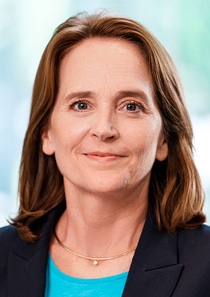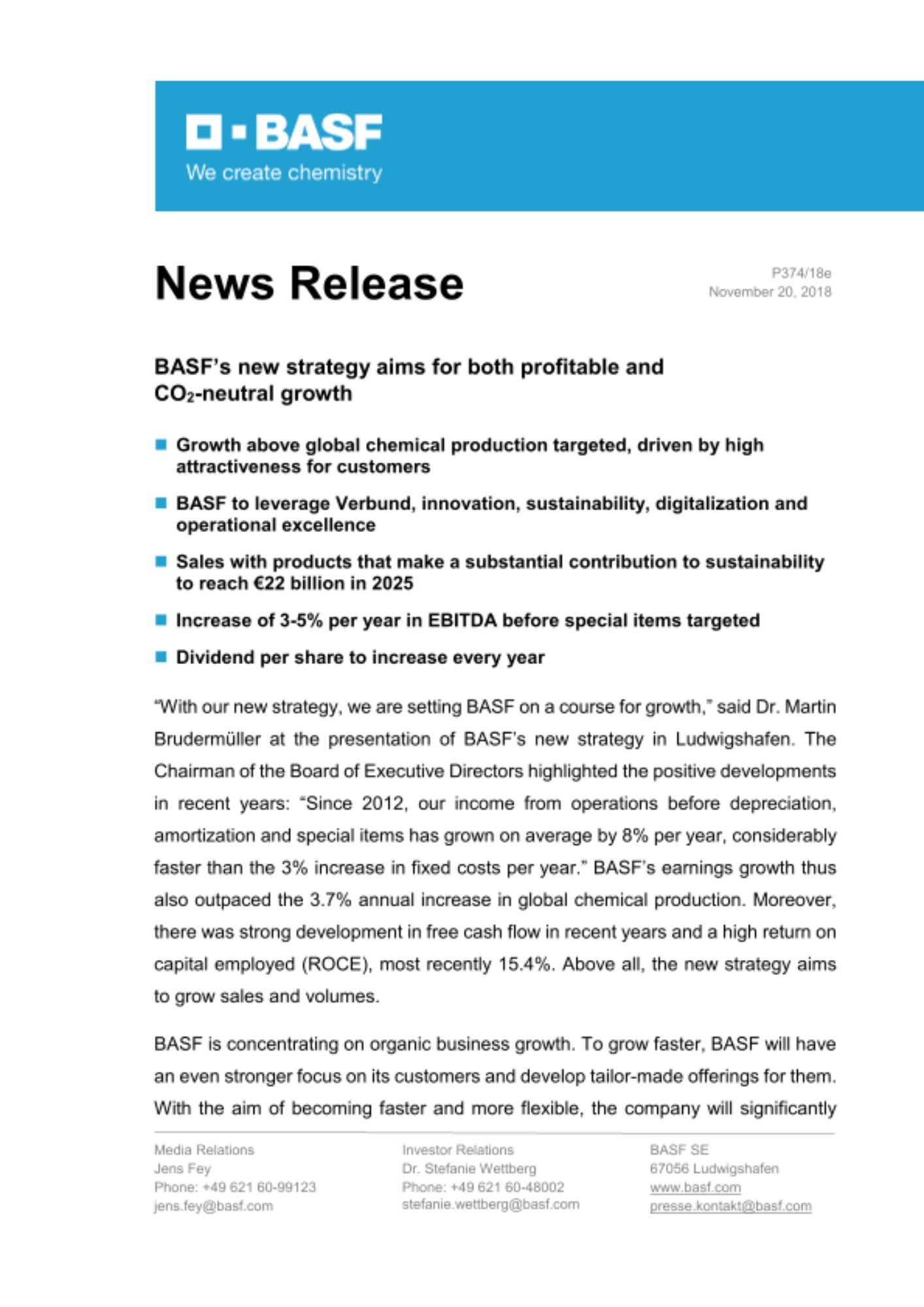Actualités & Médias
BASF’s new strategy aims for both profitable and
CO2-neutral growth
- Growth above global chemical production targeted, driven by high attractiveness for customers
- BASF to leverage Verbund, innovation, sustainability, digitalization and operational excellence
- Sales with products that make a substantial contribution to sustainability to reach €22 billion in 2025
- Increase of 3-5% per year in EBITDA before special items targeted
- Dividend per share to increase every year
“With our new strategy, we are setting BASF on a course for growth,” said Dr. Martin Brudermüller at the presentation of BASF’s new strategy in Ludwigshafen. The Chairman of the Board of Executive Directors highlighted the positive developments in recent years: “Since 2012, our income from operations before depreciation, amortization and special items has grown on average by 8% per year, considerably faster than the 3% increase in fixed costs per year.” BASF’s earnings growth thus also outpaced the 3.7% annual increase in global chemical production. Moreover, there was strong development in free cash flow in recent years and a high return on capital employed (ROCE), most recently 15.4%. Above all, the new strategy aims to grow sales and volumes.
BASF is concentrating on organic business growth. To grow faster, BASF will have an even stronger focus on its customers and develop tailor-made offerings for them. With the aim of becoming faster and more flexible, the company will significantly simplify structures and processes, sharpen its portfolio and strengthen the Verbund. “We will transform our organization to be more customer-focused and agile,” said Brudermüller.
The Asian market, where BASF is already very well established, plays an important role in its growth strategy. With a world market share of more than 40%, China is the largest chemical market and drives the growth of global chemical production. “By 2030, China’s share of the market will increase to nearly 50% and we want to participate in this growth,” said Brudermüller. “Our new Verbund site in Zhanjiang in Guangdong province and the expansion of the site in Nanjing will significantly enhance our growth in this dynamic market.”
BASF sets ambitious financial and non-financial targets
With its new strategy, BASF is pursuing ambitious targets – financial and non-financial. “We want to grow stronger than the market and we aim to grow our sales volumes above global chemical production growth,” said Chief Financial Officer and Vice Chairman of the Board of Executive Directors, Dr. Hans-Ulrich Engel.
BASF also wants to further increase profitability and targets an increase in EBITDA before special items of 3% to 5% per year. “Furthermore, BASF aims to achieve a return on capital employed well above the cost of capital percentage every year. This means we create true added value,” said Engel.
BASF also wants to be leading in the eyes of its investors and aims to deliver above-average value to them compared to the chemical industry. “Consequently, we want to increase our dividend per share every year, supported by a strong free cash flow,” said Engel.
To help achieve these ambitious targets, BASF is initiating a new excellence program which will run from 2019 until 2021. It targets annual earnings contributions of €2 billion from the end of 2021 onwards. The program will include measures focused on production, logistics, research and development as well as digitalization and automation activities and organizational development.
BASF has also set itself ambitious non-financial targets. “BASF commits to keeping its greenhouse gas emissions flat at the 2018 level until 2030 – even though we are targeting considerable annual production growth,” said Brudermüller. “This means we will decouple our greenhouse gas emissions from organic growth.” The target includes planned major investments, such as the new Verbund site in Guangdong province in southern China. To achieve this, BASF will improve the management, efficiency and integration of its plants and, wherever possible, will purchase a greater share of electricity from renewable energy sources. “Given the already very high technological standards at our plants, this is a very ambitious goal that will require exceptional creativity to do things differently,” said Brudermüller. He added that this would require a suitable regulatory environment in Germany, Europe and around the world. BASF has already reduced its greenhouse gas emissions by 50% in absolute terms compared to 1990 levels – while doubling its production volumes in this period.
In addition to the target of CO2-neutral growth until 2030, BASF wants to generate around €22 billion in sales with Accelerator products in 2025. These are products that make a substantial sustainability contribution in the value chain.
“However, none of this will be possible without our employees. That is why, for the first time, we are setting a target for employee satisfaction,” said Brudermüller. “We want more than 80% of our employees to feel that at BASF they can thrive and perform at their best.”
Action areas to achieve targets
“We want our customers to have a new experience with BASF,” said Brudermüller. Therefore, BASF will further develop its organization so it can work more effectively and efficiently and be even more customer-centric. “We want to strengthen our passion for our customers throughout the entire organization. We want to anticipate and fulfill our customers’ needs even better,” said Brudermüller. Combining BASF’s unique expertise in the chemical industry with its customers’ competencies will enable the development of solutions that are both profitable and responsible. To this end, BASF is launching a series of measures which will, among other things, increase transparency for customers, enhance customer service and explore joint growth potential. BASF will concentrate on the following action areas: portfolio, people, innovation, sustainability, operations and digitalization.
Further development of BASF’s segment structure
BASF undertook a review of its segment structure and will introduce changes as of the beginning of 2019. “We will sharpen our portfolio and focus our capital allocation more towards growing business areas,” said Brudermüller. “BASF’s new segment structure will create more transparency regarding how we steer our businesses, the importance of value chains and the role of our Verbund.”
As of January 1, 2019, BASF will have six segments, each containing two operating divisions, with the exception of Agricultural Solutions which will continue to comprise one division:
- Chemicals
Petrochemicals and Intermediates - Materials
Performance Materials and Monomers - Industrial Solutions
Dispersions & Pigments and Performance Chemicals - Surface Technologies
Catalysts and Coatings - Nutrition & Care
Care Chemicals and Nutrition & Health - Agricultural Solutions
BASF aims to clearly position its businesses against their relevant competitors and establish a high-performance BASF to enable the company to be successful in an increasingly competitive market environment.
BASF will focus primarily on organic growth through capital expenditures and innovation, but will make acquisitions where necessary. “Our main emphasis will be on designing processes to be efficient and reliable. Businesses where we cannot achieve such a position will eventually be exited,” said Brudermüller.
Verbund plays a central role
The Verbund will continue to play a central role for BASF. BASF’s portfolio has unique benefits because of physical as well as technological, market-related and digital Verbund advantages. The Verbund helps the company realize technological advantages throughout all segments. BASF can effectively support its customers with a broad portfolio.
Moreover, value chains can only be operated truly efficiently in the Verbund. Thanks to the integrated production in the Verbund, BASF achieves annual cost savings of at least €1 billion, for example, for raw materials, energy and logistics. At the same time, the company also avoids considerable emissions as a result of the Verbund. BASF will continue to lead the industry in building and developing Verbund structures and in consolidating operations at fewer, highly efficient sites.
Creating a high-performance organization
To successfully change BASF, the company is also improving internal processes and how people work together. Employees are the key to the successful implementation of the new strategy. BASF will provide flexible structures and ensure employees have the tools and skills necessary to be able to offer customers differentiated and customized products and services. “It is essential that we become faster and more agile and thus more efficient and effective,” said Engel.
As part of the further development of the organization, BASF is creating leaner structures for services, in R&D and in governance functions. By embedding significant parts of the functional services into the operating divisions, BASF is bringing its employees closer to its customers. Moreover, the remaining functional and research activities will be more efficiently organized. Approximately 20,000 employees worldwide will be directly or indirectly affected by this reorganization. “We expect all these measures to result in better differentiation of the business units as well as substantial productivity gains,” said Engel.
When appropriate, greater decision-making authority will be transferred to the business units. Engel: “This means we will enable more entrepreneurial freedom, but also assign clear responsibilities.” BASF is thus enhancing the effectiveness of the business units, and consequently improving customer satisfaction as well. To ensure that BASF captures potential market opportunities in every country, the company will introduce complementary market development models. The operating divisions will decide which local markets they will treat as focus markets served by their own personnel and in which markets they will hand over the business mandate to local country organizations. Furthermore, BASF has established a process simplification task force to focus on making key processes less complicated. The company will simplify and shorten processes and enable faster decision-making.
Solving challenges with innovative solutions
BASF has always worked on developing the most attractive innovations for its customers. “Competitiveness and customer relevance are achieved through excellence in processes and technologies. Our new strategic alignment will now bring our research units closer to business and customer needs,” said Brudermüller. BASF’s research and development will be more closely connected organizationally and thus more focused on customer needs. This will help to shorten the time to market and accelerate the company’s organic growth.
Being the leading operator
Operational excellence has always been one of BASF’s key strengths. “Our customers expect us to deliver products on spec and in time,” said Engel. “To do this, we must run our production safely, efficiently and reliably.” BASF will increase the reliability of its plants and improve flexibility. Therefore, BASF has increased its dedicated budget for boosting operational excellence to €400 million per year. This is significantly above the average in recent years.
Leveraging digitalization across the company
Digitalization offers unprecedented opportunities along the entire life cycle of BASF’s assets. For example, different processes or investment ideas can be simulated on computers, which helps to minimize costs. Augmented reality is already being used to support the BASF workforce in daily operations. BASF aims to digitalize processes at more than 350 of its plants worldwide by 2022.
Digitalization will be an integral part of BASF’s business. BASF will create additional value for customers, grow its business and improve efficiency through digitalization. It will also increase creativity in R&D, not least owing to a more intensive use of its supercomputer Quriosity. To ensure that BASF gets the best value from its data, the company will further improve data availability and quality, provide the necessary infrastructure to connect its backend systems and use existing data to support decision-making. BASF will gain speed, impact and reach in its digitalization efforts to stay ahead of its peers in the chemical industry.
About BASF
At BASF, we create chemistry for a sustainable future. We combine economic success with environmental protection and social responsibility. The more than 115,000 employees in the BASF Group work on contributing to the success of our customers in nearly all sectors and almost every country in the world. Our portfolio is organized into four segments: Chemicals, Performance Products, Functional Materials & Solutions and Agricultural Solutions. BASF generated sales of more than €60 billion in 2017. BASF shares are traded on the stock exchanges in Frankfurt (BAS), London (BFA) and Zurich (BAS). Further information at www.basf.com.
On November 20, 2018, you can obtain further information from the internet at the following addresses:
| News Release (from 8:00 a.m. CET) | |
| basf.com/pressrelease | (English) |
| basf.com/pressemitteilungen | (German) |
| Live Transmission (from 10:00 a.m. CET) | |
| basf.com/pcon | (English) |
| basf.com/pressekonferenz | (German) |
| Speech (from 10:00 a.m. CET) | |
| basf.com/pcon | (English) |
| basf.com/pressekonferenz | (German) |
|
Live Transmission – Conference for analysts and investors (from 15:00 a.m. CET) |
|
| basf.com/share | (English) |
| basf.com/aktie | (German) |
| Photos | |
| basf.com/pressphotos | (English) |
| basf.com/pressefotos | (German) |
| Current TV footage | |
| tvservice.basf.com/en | (English) |
| tvservice.basf.com | (German) |
Receive the latest news releases from BASF via WhatsApp on your smartphone or tablet. Register for our news service at basf.com/whatsapp-news.
Forward-looking statements and forecasts
This release contains forward-looking statements. These statements are based on current estimates and projections of the Board of Executive Directors and currently available information. Forward-looking statements are not guarantees of the future developments and results outlined therein. These are dependent on a number of factors; they involve various risks and uncertainties; and they are based on assumptions that may not prove to be accurate. BASF does not assume any obligation to update the forward-looking statements contained in this release above and beyond the legal requirements.
P-18-374


